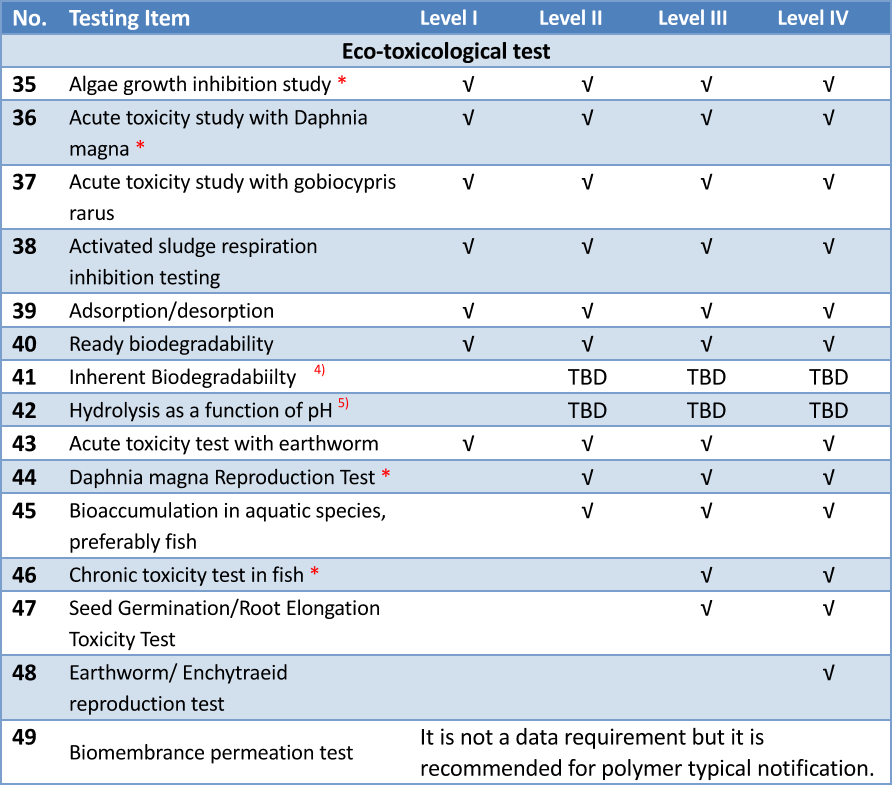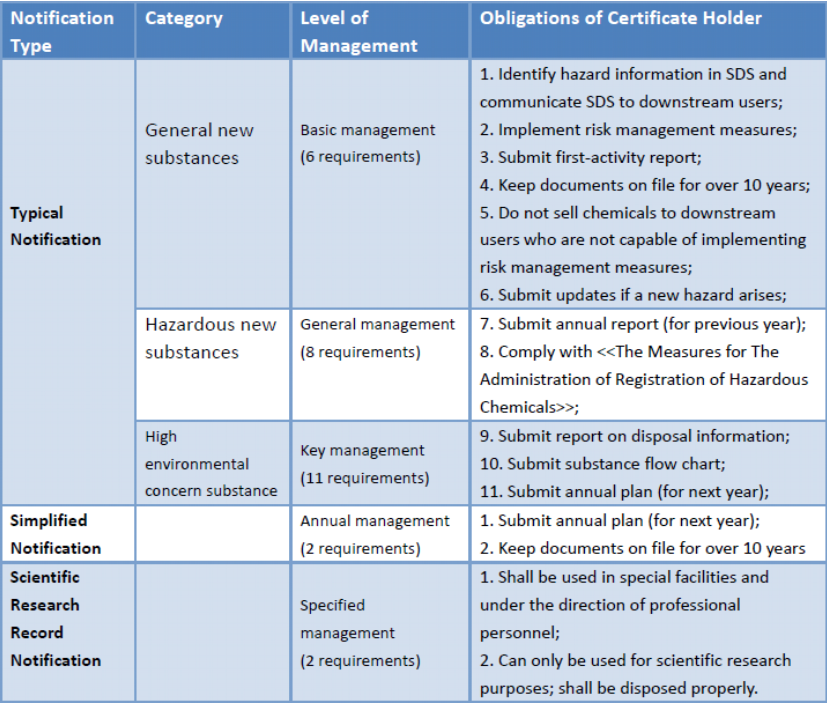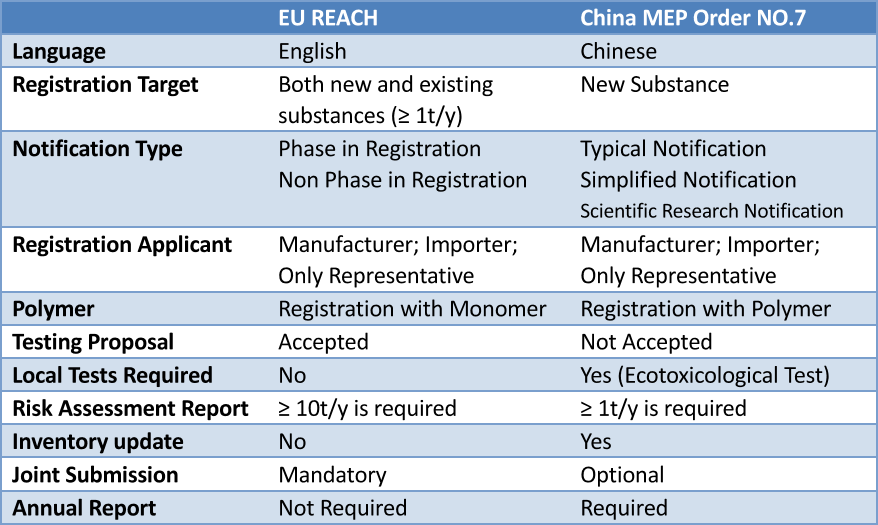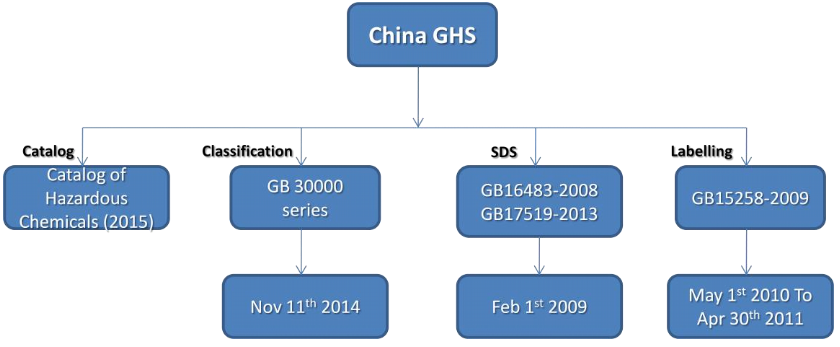China REACH
Overview
On Jan 19th 2010, the revised version of the Provisions on Environmental Administration of New Chemical Substance (MEP Order No.7) was released by Ministry of Environmental Protection (MEP).
The new chemical substance is defined as the substance which is not listed in Inventory of Existing Chemical Substances in China (IECSC). This is a dynamic inventory, which now includes 45612 substances, among which there are 3270 substances in the confidential section.
Under this regulation, manufacturers and importers shall submit new chemical substance notification to the Chinese Solid Waste and Chemical Management of the Ministry of Environmental Protection (SCC-MEP). The new chemical substances are forbidden to produce, sell or import in China without New Chemical Substance Notification.
Exemptions
There are four categories of chemical substances can be exempted from China MEP Order No.7:

Notification Bodies
Specifically, foreign companies have two options: make notifications by themselves or ask their importers to do notification. The main difference is foreign companies can sell their products to all Chinese importers after accomplishing notification by themselves. While if foreign companies ask their China importer to do notification, they can only sell their products to the Chinese importer who holds the notification certificate.
Procedure of Notification

Notification Type

Minimum data requirements of typical notification in every level are shown below. Please notice that some data requirements can be exempted based on intrinsic properties of substances. Period can be shortened and cost can be saved after data-gap analysis.



Please note:
Post-Notification Obligation
After receiving certificate of registration successfully, there are still post- notification obligations should be taken, which depends on notification type and hazardous properties of substance:

Penalty
If there is any violation behavior below, enterprises will be instructed to correct by MEP and fined 10,000 RMB at most.
If there is any violation behavior below, the local departments of environmental protection will order enterprise to make correction and report to MEP. Penalty of 10,000 to 30,000 RMB will also be fined.
If there is any violation behavior below, enterprise will be instructed to correct by local departments of environmental protection. Penalty of 10,000 to 30,000 RMB will also be fined.
EU REACH & China MEP Order NO.7
Compare to EU REACH, there are some highlighted differences between EU REACH and China REACH:

Summary
In summary, China MEP Order NO.7 is similar to EU REACH but it also has its own unique requirements including notification procedure, test requirement, dossier preparation, post-notification obligations, etc. It is mandatory to make relevant notification before produce or import products with new chemical substance in China. To EU enterprises which plan to export their products to China, they need to clarify if their products include new chemical substances and have deep understanding of China MEP Order NO.7. With the constant improvement of China regulation and more stringent supervision, EU enterprises which are involved should take initiative and proactive attitude to comply with China MEP Order NO.7.
Service offered by CIRS
IECSC Search
New Chemical Substance Notification
Post-Notification Maintenance
China GHS
China has already fully implemented their GHS standards on May 1st 2011. China GHS is based on UN GHS Rev.4. In China, GHS can be applied and required in several fields including:
In China, the general regulation of hazardous chemicals is Regulations on the Control over Safety of Hazardous Chemicals (the State Council Decree No.591), which regulate the requirements for hazard chemical enterprises when comply with China GHS in practice. In Decree No.591, illegal behaviors of China GHS and penalty are specified, which can be summarized as:
Penalty:
Besides, in China MEP Order No.7, China GHS is also mentioned in Article 30 of Chapter 4:
The certificate holder of typical notification shall list the hazard properties of the new chemical substance in chemical safety data sheet and communicate the following information to downstream users:
(b) Chemical safety data sheet;
(c) Chemical classification, precautionary label and statements.

Catalog
The Catalog of Hazardous Chemicals (2015) has been officially published on Mar 9th 2015, which includes total 2828 entries and 148 highly toxic chemicals. This catalog has been effective since May 1st 2015.
Besides this catalog, the supplementary document “Information Sheet of Hazardous Chemicals Classification” has also been published, which is similar to Annex VI of CLP. It provides minimum obligated harmonized classification requirements. To chemicals listed in this catalog, enterprises are required to use the published classifications or more severe ones to classify their chemicals and comply with requirements of SDS and label.
Classification
The national standards of classification are known as GB 30000 series, which consist of GB 30000.2-2013 to GB30000.29-2013. They have been implemented on Nov 11th 2014. The classification standards are fully based on UN GHS Rev.4 and there are 28 hazardous classifications, which include 16 physical hazardous classifications, 10 health hazardous classifications and 2 environmental classifications.
Safety Data Sheet
There are two national standards of SDS: one is National Standard on Safety Data Sheet for Chemical Products (GB16483-2008), which stipulates structure, content and general format of Chinese SDS; the other is Guidance on the compilation of safety data sheet for chemical products (GB17519-2013), which specifies SDS format, writing requirements, measurement units requirements and detailed guidance for every section of SDS in China. The Chinese SDS has standard format with 16 sections and all the headings of sections are the same as UN GHS. Nevertheless,special requirements should be noticed when preparing Chinese SDS. Specifically, a 24-hour China domestic emergency phone number is required when you make your SDS.
Label standard in China is known as National Standard on General Rules for Preparation of Precautionary Label for Chemicals (GB 15258-2009), which is issued on May 1st 2010 and fully implemented on Apr 30th 2011. Besides requirements made by UN GHS, China GHS also has requirements regarding label size, language, 24-hour China domestic emergency phone number, etc.
Summary
In summary, EU enterprises need to be careful when they comply with China GHS because of its own special requirements. They should gain insight into China GHS standards for more detailed information. SDS and label are required in multi-fields. With more stringent supervision, China GHS is playing a more significant role in chemical business communication in China. Besides, considering vast territory of China, extra requirements may be required by local customs, local safety work department, etc. Communication with local authorities is encouraged. Enterprises should be positive to handle requirements of Chinese chemical regulations and take responsibility for accuracy of their GHS information.
Per i servizi concernenti China REACH e China GHS potete rivolgervi a Flashpoint ( info@flashpointsrl.com ) in qualità di Agente esclusivo per l'Italia di CIRS - Chemical Inspection & Regulation Service
Air Jordan 3 Blue Cement CT8532 400 Release Date 1 | Nike Air Max Plus Red/Black Release Details - JustFreshKicks
